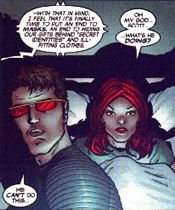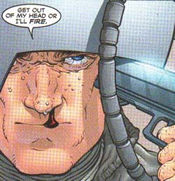>> Comment: Appointments With Disappointment
>> Comment: Accentuate The Positive?
More...

 Writer: Grant Morrison
Writer: Grant Morrison
Artists: Frank Quitely, Ethan Van Sciver
Colourists: Brian Haberlin, Hi-Fi Design
Letterer: Comicraft's Saida
Inkers: Tim Townsend, Mark Morales, Dan Green, Prentis Rollins
Collecting NEW X-MEN #114-117
Price: $12.95
Publisher: Marvel Comics
ISBN: 0785108114
Flicking across the comics racks past T, U, V and W you will reach the home of a mini-industry. Since its inception in the sixties, UNCANNY X-MEN has bifurcated its line to fill any and/or all space. The quiet end of the alphabet has always been wanting in titles; maybe the conceptual gap of X-related titles is the reason for its success. X is a positively charged letter. Its connection to the sex-industry and the unwanted edge of society has lent counter-culture authenticity to the alphabet's shifty corners.
For the sake of formality, then, what are the X-Men? Feared and hated by a world it has sworn to protect, this is the super-team portrayed as society's big brother. While other super-heroes are beloved saviours, heroics have always been a necessary inconvenience for the X-Men, something the unseen super-hero governing body requires of them. Scraping the creative barrel, the X-Men's powers do not spring from accidents, but from sheer blind luck. Gifted with an extra gene at birth that kicks into action during puberty, these "mutants" have even been castrated of interesting origin stories.
Whether X-MEN's success is in spite of or because of its One Big Idea is a fundamentally unanswerable question. At its height, it was pure soap opera, played out on a galactic scale, with lasers for eyes and great, wobbly blancmange-style telekinetic effects washing the pages. The mutants fed something the fanboy audience would never admit to. The soap opera frenzy. The idea of bigotry against people who saved the world a million times became fundamentally silly long before the series switched it's raison d'etre from creativity to commerce.
Freed from the oppressive yoke of Bob Harras, New Marvel's editorial overhaul began with the flagship of Marvel's line. Bloated and unseemly, X-MEN had spawned title after title. Quality became like a dysfunctional evolutionary niche, as the line produced a succession of ungainly monsters. If anything useful ever appeared, it was not because of the constant attempts to breed new life, but in spite of it. So the announcement of the new creative teams on the X-MEN books was both a surprise and the completion of a carefully wrought plan.
 Grant and Morrison are two words that, when used in unison, have almost as many edgy connotations as the letter X. His revolutionary work on counter-culture R&D 'thinkspace', THE INVISIBLES, was his creative coup. A drugged-up chaos magic injection into the future via the past. It seems hard to believe it's really only a few humble books on a shelf.
Grant and Morrison are two words that, when used in unison, have almost as many edgy connotations as the letter X. His revolutionary work on counter-culture R&D 'thinkspace', THE INVISIBLES, was his creative coup. A drugged-up chaos magic injection into the future via the past. It seems hard to believe it's really only a few humble books on a shelf.
Even then, the mere fictional exploits of The Invisibles were nought compared to the real life of Grant Morrison. The fifth-dimensional aliens who visited him during a drug-induced fever dream halfway through a trek up the Himalayas were probably as confused as Mr Morrison by their rendezvous.
Morrison's work often has the same effect as listening to a Manic Street Preachers song. You can bang your head to the music, but the lyrics leave you with the feeling that you should know more. Indeed, INVISIBLES often felt like a joke that only a dozen or more occultists would ever get. However, the music always played on, even if the greater subtext left you feeling as though you should have paid more attention in school.
There is also the Grant Morrison who drops camp atop Mount Mainstream. Previously, he was responsible for the lightning ascension of DC's super-team JLA in his forty-issue run. Unfortunately, that series' last hurrah bobbed uncomfortably in the wake of Warren Ellis' super-hero reinvention, THE AUTHORITY. Morrison faded from public view, marking the air with super-sigils and unlikely claims. He would be back, and we would know about it.
While it was the resolutely structured and reliable majesty of Bryan Hitch's work on THE AUTHORITY that built a following, it was Frank Quitely who stepped into his shoes and the public eye at the right moment. His demonstration of volume and intricate detailing breathed life into otherwise simplistic tales. His one previous standout was the Morrison-penned original graphic novel JLA: EARTH 2.
When the duo reunited, it was with the re-dubbed NEW X MEN. This time they were taking the fight to the mainstream; no more skulking in Mature Readers corners. It was the time for magic to remove it's aura of mystery and explode into the popular consciousness. Even the new title was magical - turn the logo upside down and it reads exactly the same. A super-sigil for the fanboys, sneaked in under their noses. After all, shouldn't somebody be able to channel all the energy of those misanthropes who beat off over the cover-mounted X-babes?
 The opening arc - plus a single-issue story to mop up the pieces and begin a new subplot - fill this rather oddly-priced collection. Four issues shouldn't cost this much, even if they're printed on the shiniest paper Marvel can find. There are some extras; Quitely's character sketches and, more importantly, Morrison's original series proposal. It's still too little for the price-point, however.
The opening arc - plus a single-issue story to mop up the pieces and begin a new subplot - fill this rather oddly-priced collection. Four issues shouldn't cost this much, even if they're printed on the shiniest paper Marvel can find. There are some extras; Quitely's character sketches and, more importantly, Morrison's original series proposal. It's still too little for the price-point, however.
E IS FOR EXTINCTION begins with a dentist observing the massacre of Neanderthal man by modern man, and gets ever more insane from there onward. The clever evocation of an unseen cycle of life that this slaughter suggests (even if it is fiction), gives the reader something to cling to as the rest of this story's claims get wilder and wilder.
The dentist is the only surviving member of the Trask family, renowned for their creation of the mutant-hunting robot Sentinels. The supremely evil Cassandra Nova has discovered a rogue pocket of Sentinels and uses the last Trask to gain control of them. What a mutant-hating telepath does with an army of cobbled-together mutant-killing robots is hardly a surprise. But it's still hard to believe that Marvel would let Morrison kill so many innocents in a short four-page sequence.
Leaping to the rescue is the core-team of Wolverine, Cyclops, Jean Grey, Beast and, now, Emma Frost. The grudging camaraderie between Wolverine and Cyclops is more the product of persistence than any mutual friendship. They're two people who've worked together for so long that they don't have time to hate. While lip service is paid to previous storylines, there is no need to have read anything before this collection. Indeed, the presentation of the team is remarkably clean and succinct. Watch the film, now read the comic.
In the follow-on issue, drawn by fill-in artist Ethan Van Sciver, we learn of the rather dull truth behind Cassandra Nova and how she ties into Professor Xavier's history. It's nice to get the answers to the questions left hanging in the main arc, but the answers aren't necessarily ones that will blow you away. That the collection ends on a cliffhanger (and a pretty big cliffhanger) is even more irritating when you realise that the follow-up will be two collections down the road. Some might call this a cynical marketing incentive. Others may see it as an innovative serialised story-telling trick. Either way, you'll be left wanting any answer after finishing this collection.
Click here to read Ninth Art's interview with NEW X-MEN and ULTIMATE X-MEN writers Grant Morrison and Mark Millar. Both Quitely and Morrison do what they've always done here. They knock it out of the ballpark. Morrison's words are super-charged with at least one hundred different connotations. They are short, sharp and every one has a point sharper than adamantium claws. While he may often short-change Quitely's chance for the money shot, he never overloads a single page. Post-AUTHORITY, we expect a certain something from Quitely, but Morrison needs all the space he can get.
The fill-in by Van Sciver is enjoyable work. He may well be a million miles from the ugly, inked beauty of Quitely, but he excels in other directions. His fine, considered lines, combined with the realistic inks of Prentis Rollins, often hide the ugly beauty that Van Sciver himself is capable of. Indeed, during the fourth issue's climactic power-struggle, some of the strangeness that got Van Sciver the job comes through.
The colouring from Hi-Fi is vibrant, energetic and up-to-the minute. Hi-Fi's work here and on the sister title, UNCANNY X-MEN, is lending a retro vitalism to the four-colour heroes, but doing so through the lens of tomorrow's SFX. The lettering from the mighty Comicraft juggernaut is able as ever, dealing admirably with Morrison's iconographic design aesthetic. The covers are refined down to the image and the logo, everything else is pushed off to one side. The title pages are more than just a brief pause in the story, they're roll-calls and a chance for the artists to impress.
NEW X-MEN was always going to be interesting, but nobody was quite sure how interesting. While there is still time for the sheen to wear off Morrison and Quitely's modern mainstream invasion, this collection represents everything you'd ever want in mutant comics. Who'd have thought that just one word could revitalise a company's business outlook? But now almost everything at Marvel is "New". Maybe the magic does work.

This article is Ideological Freeware. The author grants permission for its reproduction and redistribution by private individuals on condition that the author and source of the article are clearly shown, no charge is made, and the whole article is reproduced intact, including this notice.


